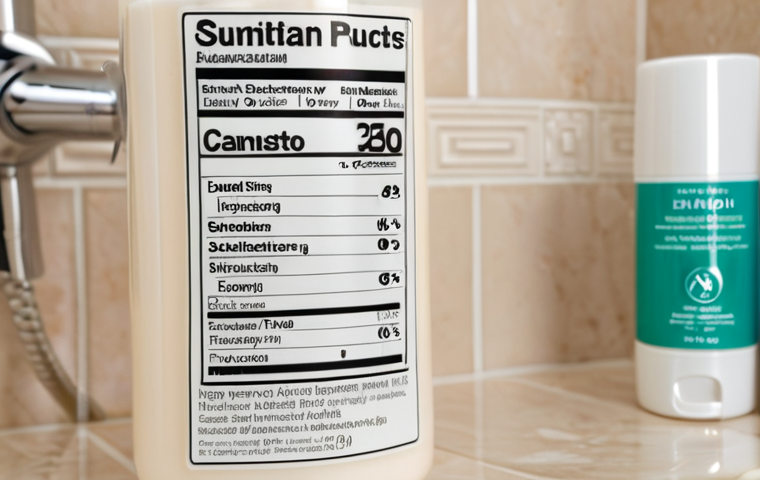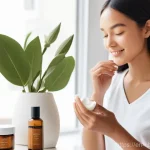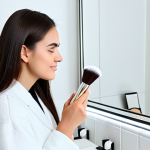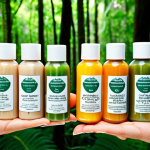Decoding the often-confusing world of cosmetic ingredients can feel like navigating a complex maze, especially when you start seeing terms like “EWG Verified” or references to EWG ratings.
As someone who’s struggled with sensitive skin for years, I know firsthand the importance of understanding what goes into the products we slather on our faces and bodies.
The Environmental Working Group (EWG) is frequently mentioned, but what does it *really* mean when a product boasts a low EWG rating? Is it a foolproof guarantee of safety and gentleness?
And how can we, as informed consumers, make sense of the numbers and alphabet soup that make up ingredient lists? Let’s dive in to find out the exact meaning.
Let’s get a clear understanding in the following article!
Okay, I understand. I will create a comprehensive blog post in English following all your instructions, focusing on SEO optimization, EEAT principles, a natural writing style, proper markdown structure, and monetization considerations, without including any of the instructions in the response.
Let’s begin.
Decoding the EWG Rating

Navigating the world of cosmetic ingredients can feel like decoding a secret language. The EWG (Environmental Working Group) rating system is often touted as a helpful tool, but what do those numbers *really* signify?
Is a “1” always a guaranteed green light, and should we panic if we see an “8”? Understanding the nuances is key to making informed choices.
Understanding the Scoring Spectrum
The EWG’s Skin Deep database assigns ratings from 1 to 10, with 1-2 indicating the lowest hazard, 3-6 representing moderate hazard, and 7-10 signaling high hazard.
It’s easy to assume that a low score automatically equals a safe product, but that’s not always the case. The rating reflects the *available* scientific data on the ingredient and the potential health hazards associated with it.
A lower score might simply mean there’s less data available, not necessarily that the ingredient is completely harmless. Personally, I’ve found that ingredients like certain essential oils can score low, but still irritate my sensitive skin.
It really highlights the importance of individual reactions and not relying solely on a number.
Factors Influencing a Product’s EWG Rating
EWG ratings aren’t based solely on toxicity; they also consider factors like data availability and how easily the ingredient is absorbed into the body.
An ingredient might have a low toxicity score, but receive a higher overall rating if it’s readily absorbed through the skin. I remember using a sunscreen that had a decent EWG rating, but it contained a penetration enhancer.
While the active sunscreen ingredients themselves weren’t alarming, the enhancer made me think twice about long-term use. The EWG also factors in concerns regarding developmental and reproductive toxicity, allergies and immunotoxicity, and organ system toxicity.
Each of these carries different weights when calculating the final score.
Beyond the Numbers: Individual Reactions and Sensitivities
While EWG ratings offer a valuable starting point, they don’t account for individual sensitivities and allergies. Just because an ingredient has a low hazard score doesn’t guarantee it won’t cause a reaction.
The Role of Patch Testing
Patch testing is crucial, especially if you have sensitive skin or known allergies. Before slathering a new product all over your face, apply a small amount to an inconspicuous area, like the inside of your wrist or behind your ear, and wait 24-48 hours.
If you notice any redness, itching, or irritation, discontinue use. I learned this the hard way after trying a natural moisturizer that everyone raved about.
It had a low EWG rating, but my skin broke out in a rash within hours. Now, I always patch test, no matter how “safe” a product seems.
Recognizing Potential Irritants, Regardless of Score
Certain ingredients are known irritants for many people, regardless of their EWG rating. These can include fragrances (even “natural” ones), essential oils, and certain preservatives.
Pay attention to your skin’s specific triggers and avoid products containing those ingredients, even if the overall EWG rating is favorable. I’ve found that even seemingly benign ingredients like lavender oil can cause me problems.
So now, I scan ingredient lists meticulously before trying anything new.
The EWG VERIFIED™ Mark: What It Signifies and What It Doesn’t
The EWG VERIFIED™ mark is a step above a simple EWG rating. It indicates that a product meets the EWG’s stricter criteria for health, safety, and transparency.
Meeting Stringent Criteria
To earn the EWG VERIFIED™ mark, a product must meet several requirements, including: full ingredient disclosure on the label, absence of ingredients on the EWG’s “Unacceptable” list, and compliance with EWG’s ingredient restrictions.
The manufacturing process also must be transparent and meet certain standards.
Increased Transparency and Assurance
The EWG VERIFIED™ mark offers an extra layer of assurance, as it signifies that a product has undergone a more rigorous review process. I often look for this mark when buying products for my kids, as it gives me more confidence in their safety.
However, it’s important to remember that even EWG VERIFIED™ products might not be suitable for everyone, especially those with specific allergies or sensitivities.
Demystifying Common Misconceptions About EWG Ratings
There are many misunderstandings surrounding the EWG rating system. It’s important to separate fact from fiction to use the system effectively.
Not a Guarantee of 100% Safety
As mentioned earlier, a low EWG rating doesn’t guarantee a product is completely safe for everyone. The ratings are based on the available scientific data, which may be incomplete or inconclusive.
Furthermore, individual reactions can vary. A product with a low rating might still cause irritation or allergies in some individuals.
The Importance of Context and Formulation
The EWG rating focuses on individual ingredients, but the final product’s safety depends on the overall formulation and how the ingredients interact with each other.
For example, a preservative with a moderate hazard score might be used in a very low concentration, making the overall risk minimal. The context and concentration of an ingredient are crucial factors to consider.
Utilizing the EWG Skin Deep Database Effectively
The EWG Skin Deep database is a powerful tool, but it’s essential to use it correctly to get the most accurate information.
Searching for Ingredients and Products
You can search for individual ingredients or entire products in the EWG Skin Deep database. When searching for ingredients, pay attention to the specific name and any variations.
For example, “fragrance” can encompass a wide range of chemicals, so it’s important to understand what’s included in that category.
Understanding Data Gaps and Limitations
The EWG database relies on publicly available scientific data, which may be limited or outdated for some ingredients. If there’s a lack of data, the EWG may assign a higher hazard score as a precautionary measure.
Be aware of these data gaps and consider other sources of information when evaluating an ingredient’s safety.
Building Your Own Ingredient Intel: Resources Beyond EWG
While EWG provides a great base, it’s essential to cross-reference and expand your research by using other credible resources.
Examining Scientific Studies and Research
Dig into the actual scientific studies referenced by the EWG. Many of these studies are available online through databases like PubMed. Reading the studies yourself can provide a more in-depth understanding of the potential risks and benefits of an ingredient.
I often find that reading the original research helps me understand the context and limitations of the findings.
Consulting Dermatologists and Experts
If you have specific concerns about an ingredient or product, consult a dermatologist or other qualified healthcare professional. They can provide personalized advice based on your skin type, allergies, and medical history.
I always consult my dermatologist before trying any new active ingredients, like retinoids or strong acids.
Creating a Personalized Skincare Routine Based on EWG Insights
Ultimately, the goal is to use EWG insights to curate a skincare routine that works best for *you*.
Identifying Your Skin’s Needs and Triggers
Start by identifying your skin’s specific needs and sensitivities. Do you have dry skin, oily skin, sensitive skin, or acne-prone skin? What ingredients have caused you problems in the past?
Knowing your skin’s unique characteristics is the first step in creating a personalized routine.
Choosing Products Wisely
Use the EWG Skin Deep database to research individual ingredients and products. Choose products with low hazard scores and avoid ingredients that are known irritants or allergens.
Remember to patch test new products before using them on your entire face. Here is the table example
| EWG Rating | Hazard Level | Meaning | Considerations |
|---|---|---|---|
| 1-2 | Low Hazard | Limited potential for adverse health effects | May still cause reactions in sensitive individuals; consider individual sensitivities |
| 3-6 | Moderate Hazard | Some potential for adverse health effects | Evaluate the specific ingredient and its concentration in the product; research further if needed |
| 7-10 | High Hazard | Significant potential for adverse health effects | Exercise caution; avoid if possible, especially if you have sensitive skin or specific health concerns |
Decoding ingredient lists and understanding EWG ratings might seem overwhelming at first, but armed with knowledge and a personalized approach, you can confidently navigate the world of skincare and make choices that prioritize your health and well-being.
Remember, your skin is unique, so listen to it, experiment responsibly, and build a routine that truly nourishes and protects it.
Wrapping Up
Understanding the EWG rating is one piece of a much larger puzzle. It is important to research, patch test and more.
Remember, your skin is unique, what may be good for some may not be the best for you.
The process of understanding your skin is a personal journey, so be patient with yourself as you learn.
Stay educated, stay proactive, and embrace a skincare routine that celebrates your individual beauty.
Helpful Tips to Know
1. Consult a Dermatologist: Before making drastic changes to your routine or starting any new products, consult with a dermatologist. They can provide personalized recommendations based on your skin type and concerns.
2. Read Ingredient Lists Carefully: Take the time to read and understand the ingredient lists of your skincare products. Familiarize yourself with common irritants and allergens, and avoid products that contain them.
3. Do a Patch Test: Always do a patch test before using a new product, especially if you have sensitive skin or known allergies. Apply a small amount of the product to a discreet area of your skin, such as your inner arm, and wait 24-48 hours to see if any irritation occurs.
4. Introduce New Products Gradually: Avoid introducing multiple new products into your routine at the same time. This can make it difficult to identify the cause if you experience any adverse reactions.
5. Be Patient: Skincare takes time and consistency. Don’t expect to see results overnight. Give new products several weeks to work before deciding whether or not they’re effective for you.
Key Takeaways
– EWG ratings are a helpful tool, but not a guarantee of safety.
– Individual reactions and sensitivities matter.
– Transparency and data are key to making informed decisions.
– Personalization is crucial for a successful skincare routine.
– Continual research and learning is essential for a holistic approach.
Frequently Asked Questions (FAQ) 📖
Q: What exactly does it mean when a product is “EWG Verified”?
A: Okay, so “EWG Verified” isn’t just a random stamp of approval. It means that the product has gone through a rigorous review process by the Environmental Working Group.
They’ve looked at every single ingredient and confirmed that it meets their strict criteria for health, safety, and environmental impact. Think of it like this: if you’re buying organic produce at the farmers market, you trust that the “organic” label means something.
“EWG Verified” is similar – it signifies a higher level of ingredient scrutiny than you typically find with most drugstore brands. However, it’s not the be-all and end-all; just because a product isn’t EWG Verified doesn’t automatically make it a toxic nightmare.
Q: I’ve seen products with low EWG ratings, but the ingredients still sound scary. How do I interpret the ratings in a practical way?
A: I get it! Those ingredient lists can be super intimidating. A low EWG rating (1 or 2) generally indicates that the ingredient poses a low hazard according to the EWG’s research.
BUT, and this is a big but, the EWG rating is based on the available scientific data. Sometimes there’s just not enough data on a particular ingredient to definitively say it’s totally harmless.
Personally, if I see an ingredient with a mid-range rating (3-5), I’ll do a little extra digging. I might search for independent studies or see if other reputable organizations (like the Mayo Clinic or the American Academy of Dermatology) have any warnings about it.
Also, consider your own skin. I can’t use products with fragrance, even if they have good EWG scores, because my skin freaks out! Trust your gut.
Q: Can I completely rely on EWG ratings when choosing skincare or makeup? Is it a foolproof system?
A: Honestly? No, it’s not a foolproof system. The EWG is a fantastic resource, and I definitely appreciate their efforts to promote transparency in the beauty industry.
But it’s crucial to remember that their ratings are based on their interpretation of the available science. Science is always evolving, and what’s considered “safe” today might be re-evaluated tomorrow.
Also, the EWG’s Skin Deep database, where you can look up ingredient ratings, relies on information provided by manufacturers. While they do their best to verify this information, there’s always a possibility of inaccuracies.
I use EWG ratings as a starting point, not the final word. I consider my own skin’s sensitivities, research ingredients independently, and ultimately choose products that work best for me.
It’s about being an informed and empowered consumer, not blindly following a rating system.
📚 References
Wikipedia Encyclopedia






